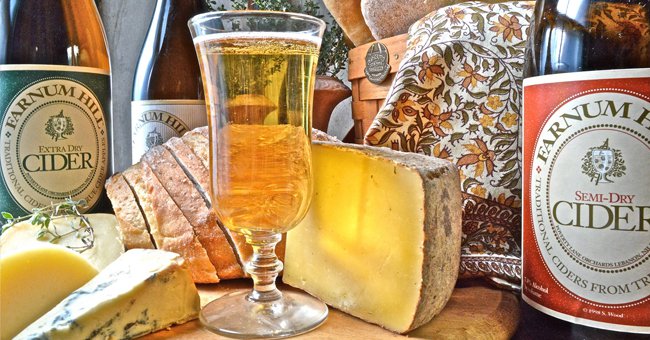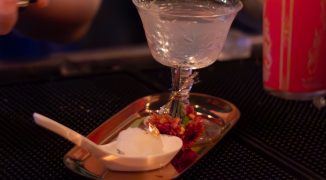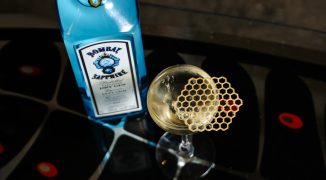For too many Americans drinkers, cider has been relegated to the unfortunate territory somewhere between “cloyingly sweet” and “embarrassing to drink.” But it doesn’t have to be that way. In fact, much like the craft beer and small-batch spirit worlds, cider is seeing a revolution of sorts.
“Today’s drinkers are becoming more and more interested in trying new things, and cider gives them something a little different from your classic beer or wine options,” Angry Orchard’s Ryan Burk says. “When it’s done well, it’s made with high-quality ingredients and intention, and I think that is what drinkers are looking for. It’s our goal to continue to innovate in the cider world, whether that’s with trying different yeast strains, uncommon ingredients, or new techniques. We’re also seeing drinkers start to experiment with hard cider much like they did with craft beer years ago, using cider as an ingredient in cooking, pairing cider with foods and even in mixology, creating some pretty interesting cider cocktails.”
As cider’s presence and influence increases, some are looking at it as a big business opportunity, while others choose to focus on experimentation. Just like any industry, there is mix of personalities and philosophies contributing to a bit of an identity crisis.
“Nobody even knows what the hell cider is,” Farnum Hill’s Steve Wood says. “The industry can’t even say what it is. There are cider guys saying the future belongs to the innovators, or that cider is only made from true cider apples that originated in a bog in the north of France or whatever, or that true cider has jalapeño in it. I think this industry, such that it is, is going to undergo a little work to define itself.”
Part of that work might be in the hands of makers around the country whose product will help define the future. While acquisitions occur and terminology gets argued, there’s plenty of delicious cider being made all over. Below, we highlight three of the United States’ most exciting producers.
Ryan Burk, Angry Orchard Hard Cider
Who: Burk grew up in New York, but made his way to Chicago for law school, where the local beer scene convinced him he was pursuing the wrong career. After helping Michigan’s Virtue Cider start up, he left for Angry Orchard where he now leads “innovation efforts and small batch experimentation at a new R&D facility on a historic 60-acre orchard in the Hudson Valley.”
Where: Hudson Valley, N.Y.
Why his ciders are special: “It really comes down to the high quality ingredients and unique apple blend we use for each of our ciders. For example, our flagship cider, Crisp Apple, took the team nearly 20 years of tinkering and experimenting with recipes until arriving at the perfect pairing. We use a blend of culinary apples and French bittersweet apples from Normandy and Brittany regions of France. They’re bred expressly for cider making and have roots in orchards that have been growing cider apples for centuries. We think it’s an incredibly balanced cider, and gives just the right amount of sweetness and tartness.”
Try this one: “We just released a new dry cider called Stone Dry. It’s the driest cider in our core collection, and one of the first ciders I’ve worked on from start to finish since joining the team. It’s an American interpretation of the traditional English dry cider style, which I’m very familiar with from my travels to the cider-rich UK. In Stone Dry, we use traditional bittersweet varieties like Dabinett, Binet Rouge, and Harry Masters Jersey to create a cider with high tannic character.”
Steve Wood, Farnum Hill Ciders
Who: Wood started working on his orchard in 1965, started managing it in 1973, and bought it in 1984. “This is where I grew up,” he says. “I’ve pretty much been doing this my whole life.”
Where: Lebanon, N.H.
Why his ciders are special: “We know how little we know. We’ve been making cider pretty much as long as anybody on a commercial scale. And we feel like neophytes. We live in a constant state of something resembling fear and eager expectation and uncertainty. We know quite a lot of stuff, but we don’t think we know nearly enough. We’re not confident in anything. We don’t feel expert. And in a way, I think our ciders reflect that. Beyond that, they’re chiefly good because we’re growers and we’ve been paying very, very close attention to the fruit we grow, and how it’s grown… When you start getting confident that you’re an expert at something, you’re probably starting to lose your expertise. We still feel like we’re muddling around in a dark closet.”
Try this one: “We don’t make a sweet cider,” Wood says. “Semi Dry or Farmhouse, the two of those aren’t intro level, but they’re not searingly dry. They’ve still got a lot of complexity, and the things we’re looking for: a big array of fruity elements, not necessarily apple, a lot citrus and tropical aromas, we want a fruit bomb, but with bright acidity and tannic structure. The Semi Dry’s got that. It’s in-your-face fruit, but it’s not sweet.”
Kevin Zielinkski, E.Z. Orchards
Who: “I am from Oregon, and have always lived here,” Zielinkski says. “I live with my wife Vicki on the farm where I was raised, so this may lead you to the conclusion of what I have done for the last 54 years.”
Where: Salem, Ore.
Why his ciders are special: “The experiences I had of drinking cider before I began my explorations are few, and I did not have an epiphany that caused me to crave cider. I did find in cider a fruit I understand, that is what pulled me toward the method I use, and the stubborn adherence to pre-prohibition and European production history. I have the intention to allow the fruit it’s truest voice in my cider. And attempting this is often thrilling and challenging.”
Try this one: E.Z. Orchards 2012 Willamette Valley Cidre Dry, describe like so on their product page: “consists of a blend of vintage French cidre apple varieties that we grow in our Willamette Valley orchards. Our fermentation method enhances matures apple aroma, is low in acidity and finishes with a soft effervescence.”




